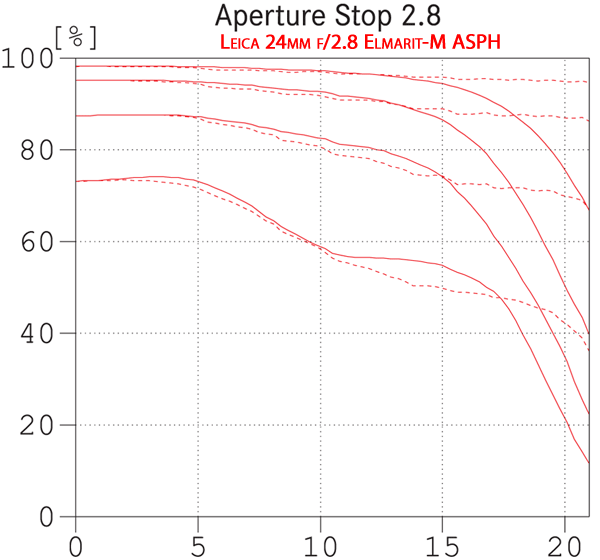EXCERPT page containing first few paragraphs. 2024-04-25 10:21:04
UA_SEARCH_BOT_compatible_botmozilla/5.0 applewebkit/537.36 (khtml, like gecko; compatible; claudebot/1.0; +claudebot@anthropic.com) @ 18.217.194.39
For full access, subscribe here. Or click title to login. ![]()
Leica MTF Analysis / Summilux, Elmarit, Elmar 24mm
Examples on this page are with the three Leica 24mm lenses.
Measurement distance is infinity for Leica MTF charts (unless otherwise noted). Leica MTF charts are for 5/10/20/40 line pairs per millimeter, yielding a very useful overall signature . They can be compared with Zeiss charts using the 10/20/40 lines.
Leica 24mm f/1.4 Summilux-M ASPH
The 24/1.4 is a very modern design, but like all 24mm lenses, it has to make some serious design tradeoffs. Both field curvature and distortion had to “give” (per Leica priorities), and a strong wave-type field curvature is present (see f/2.8), which means it won’t deliver crisp images on planar subjects, even at f/5.6.
Article continues for subscribers...
Diglloyd Making Sharp Images is by yearly subscription. Subscribe now for about 13 cents a day ($50/year).
BEST DEAL: get full access to ALL 8 PUBLICATIONS for only about 75 cents a day!
Diglloyd Making Sharp Images articulates years of best practices and how-to, painstakingly learned over a decade of camera and lens evaluation.
Save yourself those years of trial and error by jump-starting your photographic technical execution when making the image. The best lens or camera is handicapped if the photographer fails to master perfect shot discipline. High-resolution digital cameras are unforgiving of errors, at least if one wants the best possible results.
- Eases into photographic challenges with an introductory section.
- Covers aspects of digital sensor technology that relate to getting the best image quality.
- Technique section discusses every aspect of making a sharp image handheld or on a tripod.
- Depth of field and how to bypass depth of field limitations via focus stacking.
- Optical aberrations: what they are, what they look like, and what to do about them.
- MTF, field curvature, focus shift: insight into the limitations of lab tests and why imaging performance is far more complex than it appears.
- Optical aberrations: what they are, what they look like, and what to do about them.
- How to test a lens for a “bad sample”.
Intrigued? See Focusing Zeiss DSLR Lenses For Peak Performance, PART ONE: The Challenges, or (one topic of many) field curvature.


Mouse over to see f/5.6

